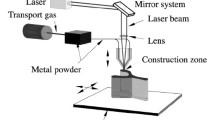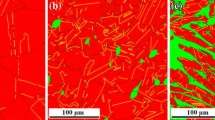Optimization of the parameters of laser cladding of an N85Yu15 nickel-alumide powder to obtain single tracks has been carried out. In the course of the experiment, the authors changed the laser-radiation power, the scanning velocity, and the position of the focus of the laser beam relative to the surface of the powder layer. It has been found that the dimensions of single tracks decrease as the scanning velocity grows. The dependence of the geometric characteristics of single tracks on the temperature of the melt pool has been investigated. The microhardness of the obtained specimens correlated with the quantity of energy imparted to the powder layer and to the melt-bath temperature. The microstructure of single tracks has been investigated. It has been established that the set of experimental data is described, in generalized space and energy coordinates, by the linear dependence. With account taken of the obtained data, multilayer objects were clad, an analysis of the elemental composition of the specimens has been made, and elemental mapping has been performed.
Similar content being viewed by others
References
D. D. Gu, W. Meiner, K. Wissenbach, and R. Poprawe, Laser additive manufacturing of metallic components: Materials, processes and mechanisms, Int. Mater. Rev., 57, 133–164 (2012).
A. G. Evgenov, E. A. Lukina, and V. A. Korolev, Distinctive features of the process of selective laser synthesis as applied to cast alloys based on nickel and intermetallide Ni3Al, Novosti Materialoved. Nauka. Tekh., 5, 3–11 (2016).
J. Dutta Majumdar and I. Manna, Laser material processing, Int. Mater. Rev., 56, 341–388 (2011).
R. Fabbro, Melt pool and keyhole behaviour analysis for deep penetration laser welding, J. Phys. D, Appl. Phys., 43, 445–501 (2010).
B. Fotovvati, S . F. Wayne, G. Lewis, and E. Asadi, A review on melt-pool characteristics in laser welding of metals, Adv. Mater. Sci. Eng., 2018, Article ID 4920718 (2018).
P. Kumar and J. Farah, Infl uence of processing parameters on properties of Inconel 718, Mater. Lett., 252, 256–259 (2019).
L. Scime and J. Beuth, Melt pool geometry and morphology variability for the Inconel 718 alloy in a laser powder bed fusion additive manufacturing process, Addit. Manuf., 29, Article ID 100830 (2019).
C. Kusuma, S. H. Ahmed, A. Mian, and R. Srinivasan, Effect of laser power and scan speed on melt pool characteristics of commercially pure titanium (CP-Ti), J. Mater. Eng. Perform., 26, 3560–3568 (2017).
E. N. Kablov, V. P. Buntushkin, K. B. Povarova, O. A. Bazyleva, G. I. Morozova, and N. K. Kazanskaya, Low-alloyed light heat-resistant high-temperature materials based on intermetallide Ni3Al, Metally, No. 1, 58–65 (1999).
E. N. Kablov, B. S. Lomberg, V. P. Buntushkin, E. R. Golubovskii, and S. A. Muboyadzhan, Intermetallide Ni3Albased alloy and advanced material for turbine blades, Metalloved. Term. Obrab. Metal., 7, 1–11 (2002).
K. G. Kumar and T. J. S. Anand, A novel intermetallic nickel aluminide (Ni3Al) as an alternative automotive body material, Int. J. Eng. Technol., 1, 274–282 (2011).
B. A. Grinberg and M. A. Ivanov, Intermetallides Ni3Al and TiAl: Microstructure and Deformation Behavior [in Russian], UrO RAN, Ekaterinburg (2002).
T. S. Skoblo and V. Ya. Petrenchyuk, Selection of a powder composition and optimum parameters of treatment in depositing coating by the laser method on camshaft cams. Distribution of chemical elements over the cross section of a part; http://marefateadyan.nashriyat.ir/node/150.
A. A. Golyshev, A. G. Malikov, A. M. Orishich, and V. B. Shulyatyev, Experimental study of laser-oxygen cutting of low-carbon steel using fibre and CO2 lasers under conditions of minimal roughness, Quantum Electron., 44, 970–974 (2014).
A. A. Golyshev, A. G. Malikov, A. M. Orishich, and V. B. Shulyat′ev, High-quality laser cutting of stainless steel in inert gas atmosphere by ytterbium fibre and CO2 lasers, Quantum Electron., 44, 233–238 (2014).
V. M. Fomin, A. A. Golyshev, A. G. Malikov, A. M. Orishich, and A. A. Filippov, Creation of a functionally gradient material by the selective laser melting method, J. Appl. Mech. Tech. Phys., 61, 878–887 (2020).
G. L. Fernando, Procedures of Optimization of the Process of Laser Deposition of Wear-Resistant Coatings on Shafts of Gas-Turbine Plants, Candidate′s Dissertation in Technical Sciences, Moscow (2017).
A. G. Grigor′yants, I. N. Shiganov, and A. I. Misyurov, Technological Processes of Laser Treatment [in Russian], MGTU, Moscow (2008).
J. Metelkova, Y. Kinds, K. Kempen, C. de Formanoir, A. Witvrouw, and B. Van Hooreweder, On the influence of laser defocusing in selective laser melting of 316L, Addit. Manuf., 23, 161–169 (2018).
A. Golyshev and A. Orishich, Study of the laser radiation focusing modes effect on geometrical and mechanical properties of metal-ceramic tracks, Met. Work. Mater. Sci., 21, 82–92 (2019).
O. P. Solonenko, A. P. Alkhimov, V. V. Marusin, Kh. M. Rakhimyanov, A. M. Orishich, R. A. Salimov, V. G. Shchukin, and V. F. Kosarev, Low-temperature plasma, in: High-Energy Processes of Processing of Materials [in Russian], Vol. 18, Nauka, Moscow (2000).
A. M. Rubenchik, W. E. King, and S. S. Wu, Scaling laws for the additive manufacturing, J. Mater. Process. Technol., 257, 234–243 (2018).
A. A. Golyshev, A. M. Orishich, and A. A. Filippov, Similarity laws in laser cladding of cermet coatings, J. Appl. Mech. Tech. Phys., 60, 758–767 (2019).
Author information
Authors and Affiliations
Corresponding author
Additional information
Translated from Inzhenerno-Fizicheskii Zhurnal, Vol. 95, No. 7, pp. 1858–1865, November–December, 2022.
Rights and permissions
Springer Nature or its licensor (e.g. a society or other partner) holds exclusive rights to this article under a publishing agreement with the author(s) or other rightsholder(s); author self-archiving of the accepted manuscript version of this article is solely governed by the terms of such publishing agreement and applicable law.
About this article
Cite this article
Gulov, M.A., Malikov, A.G. & Filippov, A.A. Optimization of the Parameters of Additive Growing of Functionally Heterogeneous Nickel-Based Materials. J Eng Phys Thermophy 95, 1809–1816 (2022). https://doi.org/10.1007/s10891-022-02654-0
Received:
Published:
Issue Date:
DOI: https://doi.org/10.1007/s10891-022-02654-0




